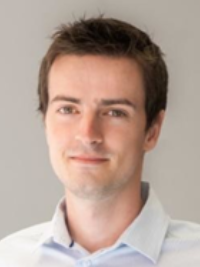After studying pharmaceutical sciences and process engineering in France (Université de Lorraine – Faculté de Pharmacie – ENSIC), Loïc worked as a Junior Research Associate in the pharmaceutical industry for two years (October 2017 – September 2019) in Belgium (Baxter R&D centre, Advanced Manufacturing Engineering group). After this work experience, Loïc joined the team of Professor Moscatelli in the framework of a Marie Curie project called CODOBIO in October 2019 and works on the continuous production of biopolymers.
Loïc likes running, playing soccer and reading contemporary books. Loïc’s areas of Research and Expertise are pharmaceutical sciences, process engineering, continuous production and automation.
Short description of project:
In today’s society, there is an increased attention and demand for sustainable plastics like polyhydroxyalkanoates (PHA). More and more studies show the interest of producing these biopolymers in biorefineries from renewable raw materials, using a mixed culture and a well-designed extraction process. The choice of carbon source, bacterial strain(s) and extraction solvent(s) are crucial to produce high quality PHA whose thermal and mechanical properties can compete with those of traditional oil-based plastics.
PHA have been known since the 1920s. Seventy years after their discovery, PHA have begun to attract great interest in the world scientific community. To produce PHAs, one or more bacterial strains that (naturally) produce these polymers are used. These bacteria are grown in bioreactors under certain conditions that favour PHA production. These steps constitute an upstream process. Studies are underway to diversify carbon sources, improve bacterial strains, improve production conditions to increase PHA yields and/or produce a particular PHA. Upstream processes for PHA production are already well developed, even on an industrial scale but they remain expensive.
After producing PHAs, we need to recover them. We have to extract the PHA from the bacteria. This step is a downstream process. The downstream processes for PHA production are often considered a bottleneck: whatever extraction technology is proposed, it is often expensive and/or has a high environmental impact.
As part of the CODOBIO (Continuous Downstream Processing of Biologics) project, I worked on the development of a more efficient downstream process for PHA production. I used the tools of ‘Smart Laboratories’ to make this process as modular, easy to use, economical and environmentally friendly as possible. Indeed, I worked on the digitalization of this continuous process thanks to cheap, open-source and reliable microcontrollers and computers. Moreover, I created a Process Analytical Technology (PAT) based on infrared spectroscopy for the real-time quantification of PHA.
What new skill/skills did you learn?
I learnt to do a lot with little. One of the “constraints” of the project was to use cheap electronic tools to automate and digitise a process. These tools had less technical performance than the tools I had used before. However, I was able to make the most of them to develop a reliable laboratory-scale platform for the extraction of PHA. I also improved my drawing and 3D printing skills.
What did you enjoy most about your project?
I enjoyed the freedom I had in choosing the experiments I had to perform in the lab. I could test many software and hardware options as long as they were cheap, often free in fact, to digitise our biopolymer extraction process. I also remember the pleasant encounters made during the CODOBIO project, in particular Professor Storti, Professor Tommasini and Professor Dotelli at Politecnico di Milano, P. Hermant and F. Moriaud in the framework of my work on infrared spectroscopy, many Makers at the Rome Maker Faire 2021, and J. Van Alstine and his wife at the BPP2022 conference.
What do you believe is your biggest contribution to the scientific community?
I believe that my greatest contribution to the scientific community was my work on the real-time quantification of PHA by infrared spectroscopy. This seems to have been of most interest to some of the experts in biopolymers and/or analytical techniques that I met at various events, including the Achema 2022 event and the BPP 2022 conference.
What would your advice be for future Early-Stage Researchers at the start of their project?
I would advise them to find out about their host structure, whether it is their host university or the companies or laboratories that will host them during a secondment. In particular, it is important to check whether these structures have the technical and human resources likely to help you carry out your research project.
What do you plan next?
I want to return to work in the biopharmaceutical industry from January 2023. As I approach the end of my activities at Politecnico di Milano, a biopharmaceutical company, which is a member of the CODOBIO consortium, has passed on to me an opportunity to work in one of its new research and production sites. At the time of writing (mid-October 2022), I have already conducted three interviews with various members of the human resources department and the team of the laboratory where I could potentially work. Other serious possibilities, notably in France, Belgium, and Switzerland, are available to me, always in the field of life sciences and process engineering.



